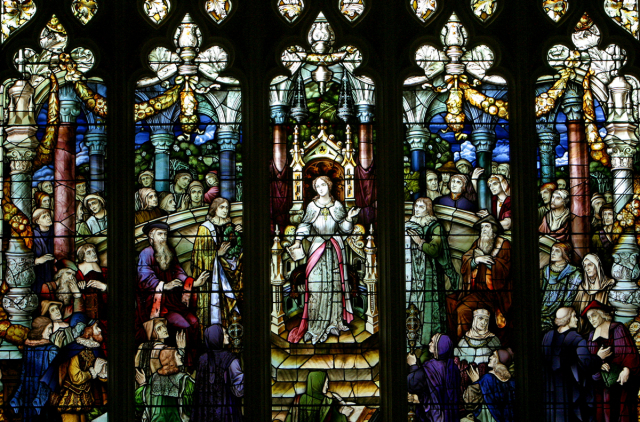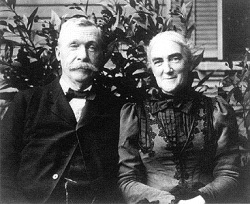Vassar’s Stellar Student, Ellen Swallow Richards, and Women’s Education in the Sciences
|
The education of women was obviously an important factor in the founding of Vassar College and the beautiful stained glass window in the Thompson Memorial Library (Figure 1) immortalizes Elena Lucrezia Cornaro Piscopia defending her thesis at the University of Padua in Italy in 1678, the first woman to obtain a Ph.D. We know from College records that the first faculty member hired by Matthew Vassar was a female astronomer, Maria Mitchell, and much has been written about this great woman and scientist. Yet, many of us do not know that there was another exceptional woman scientist who studied first at Vassar and then, MIT. Who was this dynamic, intelligent woman whose interests in science took her along different paths? She is Ellen Swallow Richards (Figure 2) and as we tour around the campus, we note that in front of Blodgett Hall, there is a plaque recognizing her contribution to euthenics (nowadays, called home economics). This remarkable woman excelled in chemistry and graduated Vassar in 1870. She was MIT’s first woman student and, as instructor in sanitary chemistry, was also MIT’s first woman teacher. After her graduation at MIT in 1873, she was offered a position in the chemistry laboratory there and her studies included analyses of the chemical composition of rocks and minerals – many of which were important because they contained elements that were rare (“the rare earth elements”) and had recently been discovered. In 1875, she published “Analysis of Samarskite from a New Locality” in Proceedings of the Boston Society of Natural History, vol. 17 where she confirmed the identity of some nuggets from North Carolina as being identical to a specimen from Russia found in 1809. In these samarskite nuggets, she identified the following metals: iron (14 percent), yttria (13 percent) and uranium (10 percent) with lesser amounts of cerium, tin and manganese. “Yttria” was used to indicate that the element yttrium and another substance that was not known and that she could not identify occurred together. In 1880, Swiss chemist Jean Charles Galissard de Marignac identified the unknown substance as gadolinium using absorption spectroscopy on the same samples she had worked on. So, in fact, Ms. Richards quite likely discovered the rare earth element, gadolinium! Her work led to her election in 1879 as the first woman member of the American Institute of Mining and Metallurgical Engineers. In 1875 she married the chairman of the MIT’s mining engineering department, Robert Hallowell Richards (Figure 2), who encouraged and supported her efforts to further women’s scientific education at MIT. They established the Women’s Laboratory in 1876 and Richards taught, without pay, as an assistant instructor, courses in chemical analysis, industrial chemistry, mineralogy, and applied biology. In 1884, MIT opened the nation’s first laboratory of sanitary chemistry and she was an instructor. Likely influenced by her chemistry professor while at Vassar, Charles Farrar, who applied scientific principles to everyday household situations, Richards was determined to use scientific principles when it came to topics dealing with the kitchen and home—good nutrition, pure foods, proper clothing, physical fitness, hygiene. In 1882 she published The Chemistry of Cooking and Cleaning: A Manual for Housekeepers. It is at this time, that she established programs of study for the new discipline of home economics. She set up model kitchens open to the public and organized conferences at Lake Placid, New York; it was there when the American Home Economics Association was formed in 1908 with Richards as its first president. The Vassar Encyclopedia writes about Richards: “Lucy M. Salmon, professor of history at Vassar—herself a renowned innovator—observed: “Mrs. Richards was among the very first to realize that the home affords an opportunity for scientific investigation and she became our first great pioneer home missionary… She discovered rich veins of interest where others had seen only prosaic humdrum duties, menial service, and uninspired, uninspiring household direction.” Bringing science into the home, Richards hoped to “attain the best physical, mental, and moral development” for the family, which she believed was the basic unit of civilization. “ In 1887, the Massachusetts State Board of Health recognized that many inland bodies of water in the state were quite polluted through industrial waste and unregulated municipal sewage and they requested Richards to analyze these waters. These studies were unprecedented and the results led to the first state water-quality standards in the nation and the first modern municipal sewage treatment plant, in Lowell, Massachusetts. From 1887 to 1897 besides continuing as an instructor at MIT, Richards served as official water analyst for the State Board of Health. She wrote a classic text in the field of sanitary engineering: Air, Water, and Food from a Sanitary Standpoint (1900) together with her colleague A. G. Woodman. A lifelong advocate of women’s education Ellen Swallow Richards co-founded with Marion Talbot in 1882, the Association of Collegiate Alumnae, and a precursor to the American Association of University Women (AAUW). In honor of Richards, MIT established the Ellen Swallow Richards Professorship in 1973 recognizing distinguished women faculty members. Announcement of the professorship coincided with the 100th anniversary of Mrs. Richards’s graduation from MIT. The chair was meant to recognize the importance of research and education by women at MIT.
Figure 1. Lady Elena Lucretia Cornaro-Piscopia
Figure 2. Ellen Swallow Richards |

